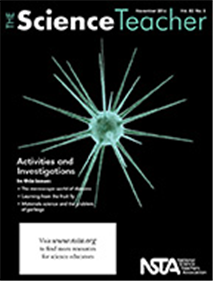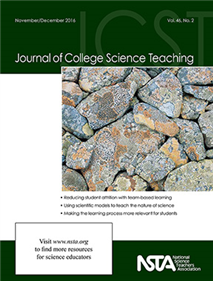All Resources
Journal Article
Idea Bank: Measurement by the Numbers
The Idea Bank provides tips and techniques for creative teaching, in about 1,000 words. This month’s Idea Bank discusses how to train students in measurement....
Journal Article
Career of the Month: Conservation Scientist
This column shares interviews with professionals using science in the workplace. This month’s issue describes Lilian Pintea's career path to becoming a conservation scientist....
Journal Article
Right to the Source: A Slightly Damaged House
Exploring science and history with the Library of Congress. This month's issue discusses the Johnstown Flood using a photograph....
Journal Article
Effects of Gender on Student Response to Course-Based Research
There is wide consensus among educators that participation in authentic research is valuable for undergraduate science students, and incorporating research into large-enrollment courses is one way to provide that opportunity to many students. There ...
Journal Article
In this article the authors describe changes in an undergraduate anatomy and physiology (A&P) curriculum designed to address educational goals at a private, comprehensive university. Educational goals included making course material more relevant to ...
Journal Article
The author describes how she has incorporated mini-research proposals into her lab courses. Students use the data they collect during class experiments as preliminary data, from which they formulate a next-step question and hypothesis, and then rese...
Journal Article
Using Citizen Science to Engage Preservice Elementary Educators in Scientific Fieldwork
Preservice elementary teachers’ lack of confidence in teaching science is an ongoing concern. Only 29% of elementary teachers in the field felt “very well prepared to teach life science,” according to the National Survey of Science and Mathemat...
By Catherine M. Scott
Journal Article
Team-Based Learning Reduces Attrition in a First-Semester General Chemistry Course
Team-based learning (TBL) is an instructional method that has been shown to reduce attrition and increase student learning in a number of disciplines. TBL was implemented in a first-semester general chemistry course, and its effect on attrition was a...
Journal Article
In the Midst of a Shift: Undergraduate STEM Education and “PBL” Enactment
In the engineering field, problem- and project-based learning, both of which are often referred to as PBL, are the dominant instructional models called for by accreditation agencies. The aim of this qualitative case study is to analyze and capture a ...
Journal Article
Through this case study, the authors offer insight into the value of using qualitative methods in course assessment to science instructors in higher education....
Journal Article
Three college faculty taught large general biology classes using case studies and personal response systems (clickers). Each instructor taught the same eight cases in two different sections, except the questions within the cases differed. In one sec...
Journal Article
The purpose of this study was to determine whether there is a difference in spatial visualization ability between college students in STEM (science, technology, engineering, and mathematics) fields and those in non-STEM fields. The study also examine...
Journal Article
Point of View: In Defense of the Lecture, Revisited
This column shares reflections or thoughtful opinions on issues of broad interest to the community. This month’s issue discusses the value of traditional lecturing....
Journal Article
State and national data suggest a strong correlation between student performance in STEM subjects and student socioeconomic status, race, and ethnicity. Queensborough Community College is situated in one of the most ethnically diverse areas in the co...
Journal Article
This column provides original articles on innovations in case study teaching, assessment of the method, as well as case studies with teaching notes. In the nonmajor science classroom, case studies—when used as learning tools—should help students ...
eBook
Disciplinary Core Ideas: Reshaping Teaching and Learning (e-book)
Like all enthusiastic teachers, you want your students to see the connections between important science concepts so they can grasp how the world works now—and maybe even make it work better in the future. But how exactly do you help them learn and ...
Book Chapter
Introduction to DCIs: What They Are and Why They Are Important
This chapter serves as an introduction to Disciplinary Core Ideas (DCIs). As a whole, DCIs help students build usable knowledge that is central to the physical sciences but also across the life sciences, Earth and space sciences, and engineering. The...
Book Chapter
Core Idea PS1: Matter and Its Interactions
This chapter focuses on matter and its interactions and discusses the importance of how a rich understanding of atomic theory leads to a deeper understanding of why there are so many different substances in the world. A full understanding of matter a...
Book Chapter
Core Idea PS2: Motion and Stability: Forces and Interactions
This chapter discusses the disciplinary core idea of forces and interactions which consists of three component ideas that are described here. If any idea is a core concept, it is the idea of forces and interactions. Forces affect every single thing i...
Book Chapter
This chapter focuses on energy—perhaps the most important idea in all of science. It is used by every scientific discipline and applies to all known natural phenomena. Students hear and use the word “energy” from a very early age, but developin...
Book Chapter
Core Idea LS1: From Molecules to Organisms: Structures and Processes
In this chapter, the disciplinary core idea (DCI) is central to biology and also serves as the glue connecting all four DCIs in the life sciences strand. In essence, it is about the properties of living things and explaining the complexity of life an...
Book Chapter
Core Idea LS2: Ecosystems: Interactions, Energy, and Dynamics
This chapter begins by suggesting three ways in which a deeper understanding of ecosystems could enrich students’ lives and support their participation as informed citizens in society. The three ways are by: developing a deeper appreciation of the ...
Book Chapter
Core Idea LS3: Heredity: Inheritance and Variation of Traits
The heredity disciplinary core idea (DCI) is about the biological mechanisms that underlie many familiar and less familiar phenomena such as genetic disorders, genetically modified foods, gene therapy, and others. Explaining how and why we are simila...
Book Chapter
Core Idea LS4: Biological Evolution: Unity and Diversity
This chapter has hopefully provided a bit more insight into the disciplinary core idea (DCI) of Evolution: Unity and Diversity. Taking an evolutionary perspective on biology is one of the most powerful ways that scientists make sense of and reason ab...
Book Chapter
Core Idea ESS1: Earth’s Place in the Universe
Earth and space sciences consists of three disciplinary core ideas (DCIs) that help to explain a wide variety of Earth-related phenomena, including the motion of the planets, changes in climate, and the shape of Earth structures. In this chapter, the...
Book Chapter
Core Idea ESS2: Earth’s Systems
The Earth exists as one large system, consisting of an array of interconnected subsystems. Often, scientists focus their efforts on exploring and explaining smaller, individual subsystems or even smaller relationships within these subsystems. However...
Book Chapter
Core Idea ESS3: Earth and Human Activity
Of all the fields of scientific study, the Earth sciences are one of the most interdisciplinary. This is particularly true for this disciplinary core idea (DCI), which focuses on society’s interactions with the planet’s complex systems. Today, Ea...
Book Chapter
Core Idea ETS1: Engineering Design
The engineering, technology, and applications of science disciplinary core ideas (DCIs) address questions about the ways in which engineers use science to develop solutions, the process of design, and the effects of our designed world on nature and, ...
Book Chapter
Core Idea ETS2: Links Among Engineering, Technology, Science, and Society
This component of the disciplinary core idea (DCI) brings together two movements in science education—environmental education and science, technology and society. Learning about the Influence of engineering, technology, and science on society and t...
Book Chapter
This lesson helps students understand the function of the nucleus, cell membrane, cell wall, mitochondria, and chloroplasts. Students will relate the structure of each organelle to its function, develop and use a model to explain the functions of org...
Book Chapter
This lesson helps students: develop and use a model to explain the inheritance of traits; predict the frequency of genotypes and phenotypes in a cross; recognize that each parent contributes equally to the genotype even when the recessive trait is no...
Book Chapter
Seriously …That’s Where the Mass of a Tree Comes From?
This lesson helps students identify photosynthesis as the process through which plants make glucose, determine that most of the mass of a plant comes from carbon dioxide, explain that plants use glucose for energy and raw materials for plant growth a...
Book Chapter
Chemistry, Toys, and Accidental Inventions
This lesson helps students distinguish between reactants and products, explain the law of conservation of matter, measure properties or reactants and products, recognize that a change in the reactants results in a difference in the products, observe ...
Book Chapter
Nature’s Light Show: It’s Magnetic!
This lesson helps students draw and describe Earth’s magnetic field, explain the phenomenon of the aurora, summarize a text, including the central ideas and supporting details, and synthesize information gained from investigations and text. The inv...
Book Chapter
Thermal Energy: An Ice Cube’s Kryptonite!
This lesson helps students recognize that different materials have different thermal properties, distinguish between qualitative and quantitative measurements of temperature, illustrate that thermal energy moves from areas of high heat to areas of lo...
Book Chapter
This lesson helps students to recognize that interventions can slow or stop the negative impact of human activities on the environment, identify strategies for reusing natural resources, investigate ways to reduce municipal solid waste, draw conclusi...
Book Chapter
This lesson helps students to develop and use a model of the Sun–Earth system to explain: the relationship between the amount of sunlight and the season; the relationship between the angle of incidence of sunlight and the season; and the reason the...
Book Chapter
This lesson helps students explain that Earth’s history is broken up into smaller time periods and rocks and fossils provide evidence for these time periods. Students synthesize information gathered through investigations and text. The investigatio...
Book Chapter
This lesson helps students recognize that secondhand evidence can be used to answer scientific questions, describe how organisms change over time in response to environmental pressures, compare anatomical differences between modern and ancestral orga...






